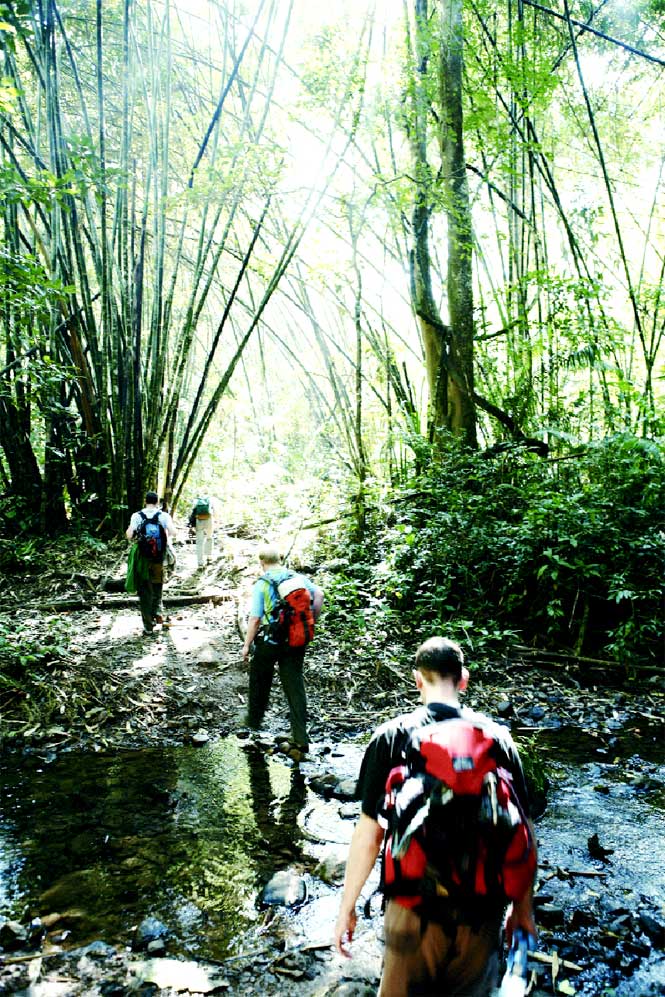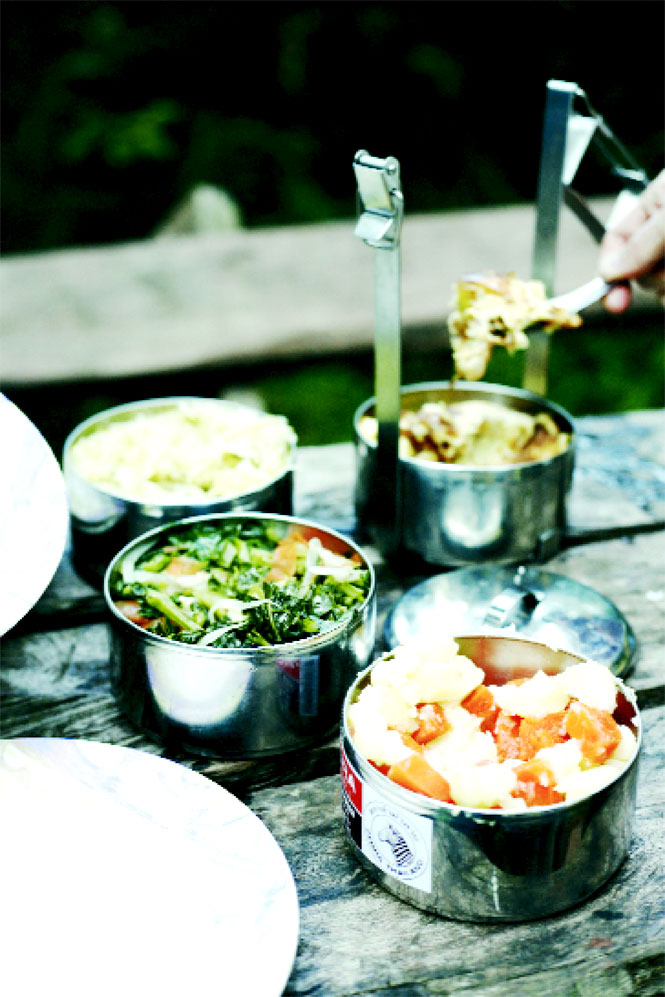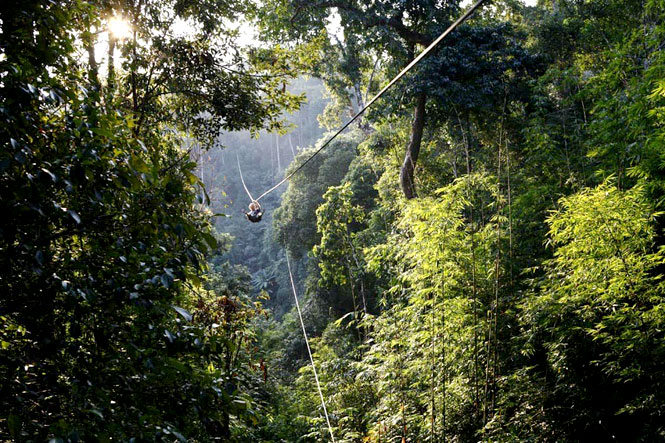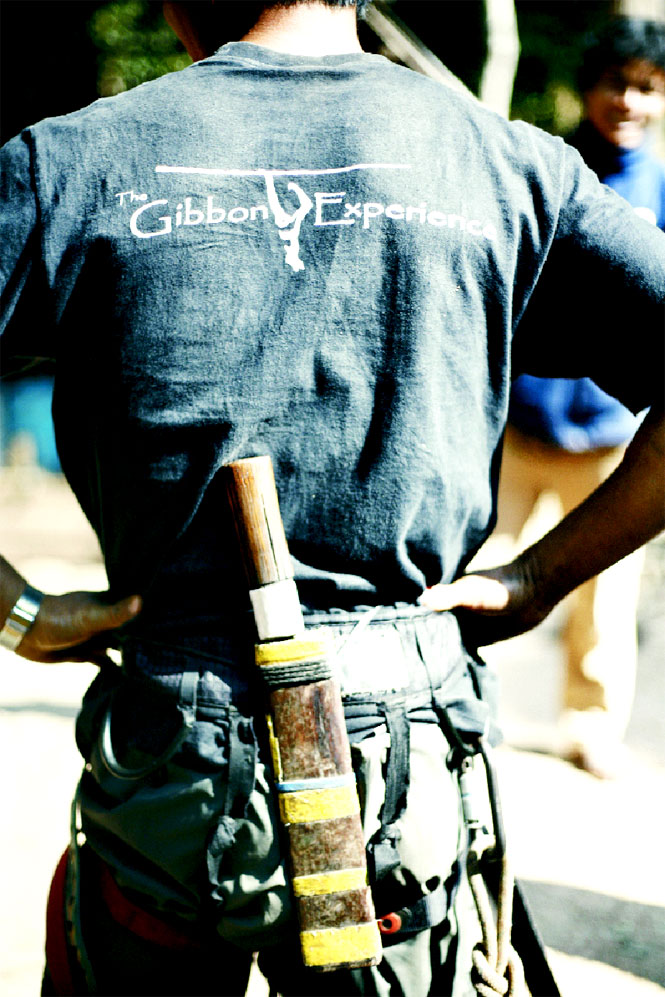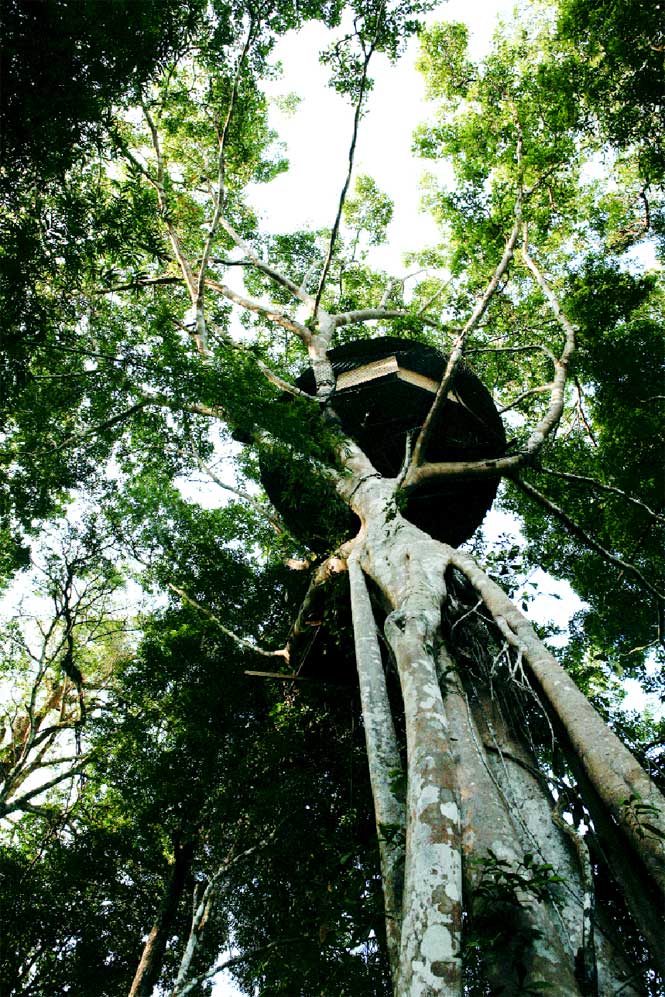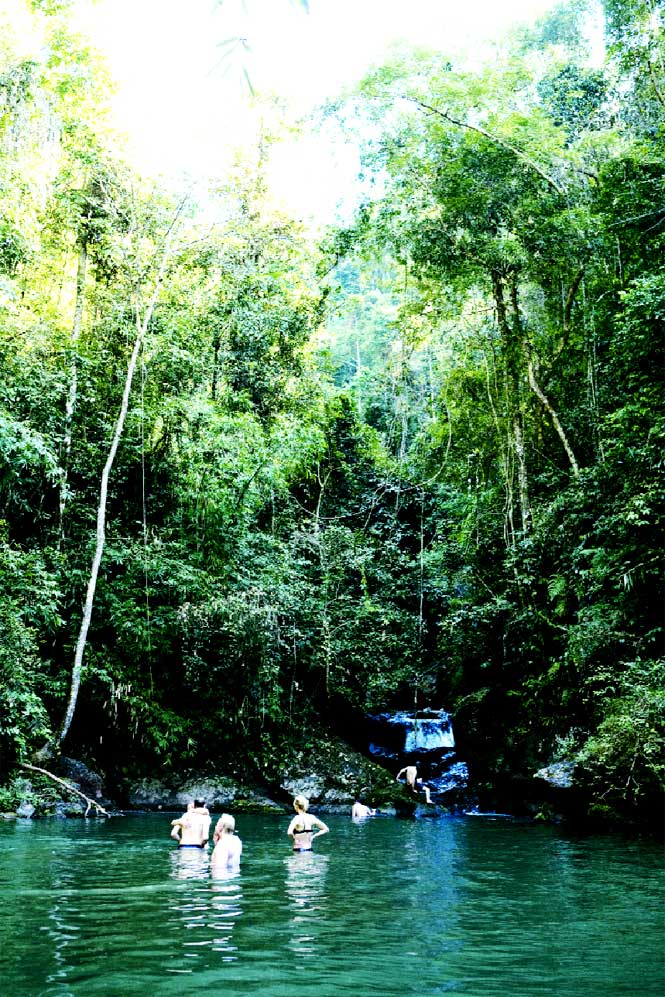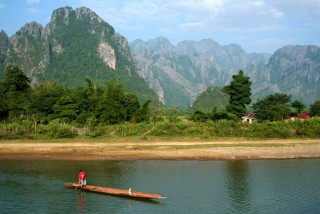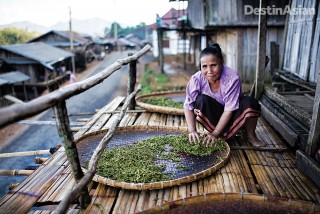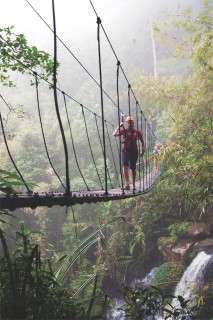Above: Zip lining in the Bokeo Nature Reserve.
Conservation and adventure meet in the treetops of northern Laos
By Christopher Wise
The afternoon sun casts slanting shadows across the valley. From my bamboo-shrouded nook on the forest floor, I hear a whoo whoo ring out over the giant palms and towering teak and ficus trees. Could this be one of the western black-crested gibbons I have traveled here to see? The rarest of five species of gibbon known to inhabit the jungles of Laos? Whatever it is, it’s approaching fast. Suddenly, a long-limbed creature, legs splayed wide, whizzes high over my head, whooping as it brushes the canopy 100 meters above. No, it’s not my elusive ape. It’s my human friend Pepe, enjoying a wild ride across the valley on an almost-invisible cable. I look sideways at my other companion, a photojournalist who answers to the name Buffalo. “Another zip before sunset?” he asks.
We’re on the fringe of the 123,000-hectare Bokeo Nature Reserve in northwestern Laos, looking for an escape from life’s stresses—Buffalo from months covering the fighting in Afghanistan; Pepe from a film set in London; and me from the traffic and protests of Bangkok. The Gibbon Experience offers the perfect cure. Established in 2006 by eco-tourism outfit Animo, this high-flying conservation project takes visitors deep into the forests of Bokeo with the goal of promoting awareness of this fragile ecosystem, threatened for decades by slash-and-burn agriculture and widespread deforestation. We’re here to climb tree houses and fly on zip lines above the jungle canopy, and to forget our lives for a little while. Spotting a gibbon or two along the way will be a bonus.
The Gibbon Experience is headquartered in the Laotian border town of Huay Xai, across the Mekong from northernmost Thailand. From the Thai city of Chiang Rai, we ride a little red schoolbus that rocks and shimmies along patchy roads to the river crossing, two-and-a-half hours away. Across the water, Huay Xai appears as a shantytown—and I mean that in the best possible sense. It’s rickety and undeveloped, with a main drag lined with wooden shophouses and not a tour or billboard to be seen. As escapes go, it’s ideal.
At the Gibbon Experience office, we register for our ecotourism adventure by signing waivers that hold “forest spirits or malevolent gods” responsible for any mishaps that might occur in the coming days. The organization runs two excursions: the Waterfall trip, involving long treks through remote rain forest, and the Classic trip, for groups who are after something more relaxed and with more time for ziplining.
We sign up for both, and spend the rest of the afternoon stretched out on our hotel’s rooftop terrace. As the sun dips toward the hills beyond the river, the three of us snack on a local treat called miang lao—roasted peanuts, palm sugar, deep-fried pork skin, and fresh coriander wrapped in steamed cabbage leaves—washed down with cold Beer Lao. Buffalo calls it “the Dom Pérignon of Asian beers.”
Early the next morning, we set out in a four-wheel-drive for Bokeo, about an hour’s drive from Huay Xai. The journey takes us along newly tarred roads cut through steep mountain passes that end in tiny bamboo villages surrounded by rice fields. The hills are mohawked, clean-shaven but for the tops—evidence of decades of slash-and-burn farming and ongoing logging. Mudslides occasionally creep onto the road. Given the state of the countryside, I’m skeptical that we’ll ever find the jungle paradise that we’ve been promised.
The jeep makes an abrupt turn off the tarmac, plunging down a dirt road and across a wide stream. Soon we’re climbing again along a ridgeline that offers dramatic, but contrasting views of the valley. On one side, small villages appear plonked amid patchy forest; on the other, dense primordial jungle extends as far as we can see. We head toward the latter, and soon come to a halt at the village of Ban Toup on the edge of the reserve. Eager for action, we sling on our packs and follow our guides into the trees.
Giant palms block out the sky as soon as we enter the forest. Clumps of soaring ficus cast eerie, wavering shadows overhead. As we follow the trail along a steep ridge and emerge from under a bower of storm-wracked bamboo, we spot a tree below us that stands out from the rest. It looks to be about 50 meters tall, and high in the crotch of its outstretched limbs is perched a round wooden tree house—our home for the night. But how on earth are we going to get up there? Our head guide, a wiry Laotian who introduces himself as Charlie, leads us farther along the ridge to a timber platform at the base of another enormous tree. Wrapped around the trunk is a cable as thick as my thumb; it extends out into the void, dipping slightly before rising to meet the tree house some 150 meters away. Looking at each other, Pepe, Buffalo, and I share what can only be described as a moment of undiluted adolescent glee. This is going to be fun.
But first, we’re given a crash-course in ziplining: how to secure our diaper-like harnesses; how to attach a zip roller and back-up safety line; how to brake if we’re moving too fast; how to “steer” if we start spinning on the line. Then, with a smirk, Charlie launches himself off the platform, flying headfirst and almost upside down through the sun-dappled foliage. The only sound is the whine of the zip line as it sags under Charlie’s weight.
My first ride on the wire is not as graceful. I’m flying at about 50 kilometers an hour when I realize that the treehouse is approaching fast and that my legs—spread at a 90-degree angle—are nowhere near where they should be to ensure a smooth landing. Yet somehow I survive, and find myself on the terrace of a fantastical, multilevel tree house overhung with a roughly thatched roof—think Swiss Family Robinson meets Robinson Crusoe. The only “wall” is a bamboo screen flanking the squat toilet, where you can do your business while admiring the panoramic sweep of the forest. We quickly dub the facility “poo with a view.”
Most of the eight zip lines that cut through the forest at the Waterfall site are no more than 500 meters long. Some are steeper than others. On the gentler declines, when the ride is slower, there’s time to absorb the scenery: an ocean of green valleys, peaks, and ridges as far as the eye can see. We fly over and over again, whooping and hollering with delight. It’s infectious, cathartic. There’s no ziplining allowed after dark, so as the sun descends we retire to our treetop lair for dinner. Our guides zip in with tins of steamed garlicky vegetables as well as pork fried with wild mushrooms and a bamboo basket of rice. After our meal, we challenge each other to rounds of backgammon and card games accompanied by sips of the rough Lao rice whiskey that Pepe had smuggled in. It’s a guilty pleasure: the Gibbon Experience manual requests guests to refrain from drinking alcohol. It also discourages drugs, “as you are already doing lines in the jungle.”
The aroma of freshly brewed coffee and tea wakes us early the next morning, followed by a simple breakfast of rice, fried with leftovers from dinner. Over our meal, Charlie’s brother Max, one of the youngest guides, tells us that he dropped out of high school a couple of years ago, unable to pay the tuition. With Charlie’s help, he managed to get work with Animo. Max tells us that he now earns enough extra money to keep his sister in school. The 40 other Laotians employed by the Gibbon Experience share similar tales.
The local community isn’t the only benefactor of the program. The brainchild of Frenchman Jeff Reumaux, Animo uses proceeds from its zip-line enterprise to hire forest rangers, who patrol Bokeo against poachers. Aside from the black-crested gibbon, the reserve is home to a host of other endangered animals—bears, tigers, wild buffalo, and elephants among them. Orphaned and injured animals found by the rangers are cared for in Animo’s rehabilitation center, also in the reserve. The organization plans to employ an increasing number of locals to manage additional tree houses and zip lines, with an eye to turning the project over to Lao ownership sometime in the future. It’s a goal as lofty as the tree houses, but if Max’s story is anything to go by, the benefits are already trickling down.
We spend the entire day zipping across the forest, mastering new poses on every fly. We’re momentarily excited by the sight of a furry black mammal—a gibbon?—only to discover that it’s a giant black squirrel. Around our tree house we also spy a racket-tailed drongo and a menagerie of other birds, including colorful barbets, stripe-throated bulbuls, and long-beaked babblers. Their cries echo across the valley.
The next day we set out for the Classic section of the experience, trekking along a steep path that takes us deep into the rain forest. We arrive at camp around 3 p.m., and wile away the rest of the afternoon on the small platform ringing our tree house, sipping whiskey while listening to an orchestra of frogs, birds, and cicadas. I stare out into the jungle, the great tree swaying underneath me. Pepe pulls out his binoculars and ticks off bird sightings in a nature guide we find in our room.
Early the next morning, with mugs of hot tea in hand, we watch the sun burn off the dew that blankets the canopy. Then, dozing under my duvet again, I hear what sounds like a siren. Pepe and Buffalo sit bolt upright beside me. I hear it again, this time with an intensity that reverberates through the trees. And again. Gibbons! We scramble up to the railing and peer out over the jungle, hoping to catch a glimpse. The shrill call rings out again, this time accompanied by another otherworldly voice, crying out in harmony and with increasing frequency. It’s mesmerizing.
The humming zip line snaps us back to reality. Our new guide, Tchaa, lands on the platform. “You hear?” he asks, pointing to a tall teak tree jutting above the canopy. “Gibbon! Let’s go.”
Despite his worn rubber sandals, Tchaa moves briskly and soundlessly through the forest. In our state-of-the-art hiking shoes, we churn up a riot of leaves and twigs trying to keep pace. From time to time our guide shoots us a withering glare, warning us to keep quiet lest we scare off the apes. This continues for about a kilometer before Tchaa comes to a halt. He crouches down, takes a deep sniff, and motions for us to sit and listen. About 60 meters away, the branches of a tall ficus start to tremble. There’s a flash of black. Then the canopy is quiet again. We sink a little lower into the understory, trying to make ourselves invisible. Slowly, Tchaa points his arm skyward. A black-crested gibbon sits on a branch, munching casually on a handful of fruit. A golden-haired gibbon with a baby sits nearby. For the next 15 minutes we huddle in the moist leaves, exchanging binoculars, video cameras, and happy glances.
“You are very lucky,” Tchaa says when the apes finally swing off into the forest, far more gracefully than our maneuvers on the zip line.
The remainder of the day is spent trying to imitate the creatures we’ve just met: we almost wear out the cable connecting our tree house to a tall teak on the far ridge. We keep flying until dusk, absorbing the vastness of the rain forest and marveling at how far away city life seems. It’s hard not to get caught up in the magic when you’ve heard a pair of gibbons sing a duet and flown as high as their song could carry you.
The Gibbon Experience (856/8421-2021; gibbonx.org) offers two zip-line experiences in the Bokeo Nature Reserve: the Classic and the Waterfall, both costing US$225 for two nights, all-inclusive.
Originally appeared in the May 2009 print issue of DestinAsian magazine (“High-Wire Act”)

